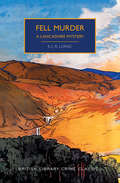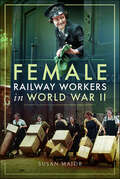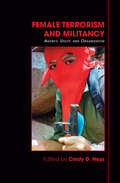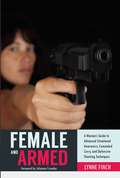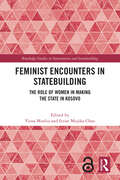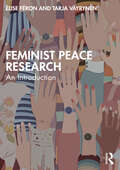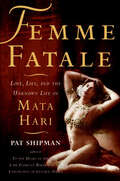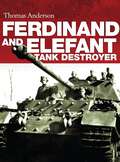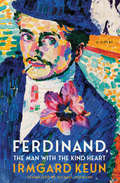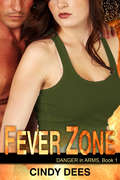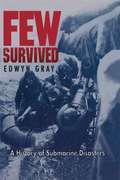- Table View
- List View
Fell Murder (British Library Crime Classics)
by E.C.R. LoracMystery crime fiction written in the Golden Age of MurderA classic Golden Age mystery from acclaimed author E.C.R. Lorac '...this crime is conditioned by the place. To understand the one you've got to study the other.'The Garths had farmed their fertile acres for generations, and fine land it was with the towering hills of the Lake Country on the far horizon. Here hot-tempered Robert Garth, still hale and hearty at eighty-two, ruled Garthmere Hall with a rod of iron. Until, that is, old Garth was found dead—'dead as mutton'—in the trampled mud of the ancient outhouse.Glowering clouds gather over the dramatic dales and fells as seasoned investigator Chief Inspector Macdonald arrives in the north country. Awaiting him are the reticent Garths and their guarded neighbors of the Lune Valley; and a battle of wits to unearth their murderous secrets.First published in 1944, Fell Murder is a tightly-paced mystery with authentic depictions of its breathtaking locales and Second World War setting. This edition also includes the rare E.C.R. Lorac short story 'The Live Wire'.
Female Railway Workers in World War II
by Susan MajorDuring World War II women took on railway roles which were completely new to females. They worked as porters and guards, on the permanent way, and in maintenance and workshop operations. In this book Susan Major features the voices of women talking about their wartime railway experiences, using interviews by the Friends of the National Railway Museum. Many were working in ‘men’s jobs’, or working with men for the first time, and these interviews offer tantalising glimpses of conditions, sometimes under great danger. What was it about railway work that attracted them? It’s fascinating to contrast their voices with the way they were portrayed in official publicity campaigns and in the light of attitudes to women working in the 1940s. These women talk about their difficulties in a workplace not designed for women – no toilets for example, the attitudes of their families, what they thought about American GIs and Italian POWs, how they coped with swearing and troublesome colleagues, rules about stockings. They describe devastating air raids and being thrust into tough responsibilities for the first time. This book fills a gap, as most books on women’s wartime roles focus on the military services or industrial work. It offers valuable insights into the perceptions and concerns of these young women. As generations die out and families lose a direct connection, it becomes more important to be able to share their voices with a wider audience.
Female Terrorism and Militancy: Agency, Utility, and Organization (Contemporary Terrorism Studies)
by Cindy D. NessThis edited volume provides a window on the many forces that structure and shape why women and girls participate in terrorism and militancy, as well as on how states have come to view, treat, and strategize against them. Females who carry out terrorist acts have historically been seen as mounting a challenge to the social order by violating conventional notions of gender and power, and their participation in such acts has tended to be viewed as being either as a passive victim or a feminist warrior. This volume seeks to move beyond these portrayals, to examine some of the structuring conditions that play a part in a girl or woman’s decision to commit violence. Amidst the contextual factors informing her involvement, the volume seeks also to explore the political agency of the female terrorist or militant. Several of the articles are based on research where authors had direct contact with female terrorists or militants who committed acts of political violence, or with witnesses to such acts.
Female Tommies: The Frontline Women of the First World War
by Elisabeth ShiptonThis book tells the story of women in the First World War at the front line, under fire, and in combat. Through their diaries, letters and memoirs, meet the women who defied convention and followed their convictions to defend the less fortunate and fight for their country. Follow British Flora Sandes as she joins the Serbian Army and takes up a place in the rear-guard of the Iron Regiment as they retreat from the Bulgarian advance. Stow away with Dorothy Lawrence as she smuggles herself to Paris, steals a uniform and heads to the Front. Enlist in Russia’s all-female ‘Battalion of Death’ alongside peasant women and princesses alike. Through the letters, diaries and memoirs of women who were members of organisations such as the US Army Signal Corps, the Canadian Army Medical Corps, the FANY, WRAF, WRNS, WAAC and many others, we learn what life was like for them on the front and discover the courage of the women who took up arms.
Female and Armed: A Woman?s Guide to Advanced Situational Awareness, Concealed Carry, and Defensive Shooting Techniques
by Lynne Finch Julianna CrowderIn Female and Armed Lynne Finch offers an information-packed follow-up to her first book, Taking Your First Shot. Based on questions and requests from readers, this book addresses more advanced techniques for personal defense as well as range drills to help readers practice and hone those skills. It’s important to know how to defend yourself, and Finch provides the building blocks necessary to successfully navigate some dangerous, real-life scenarios. Be it a carjacking, robbery, or home invasion, readers will learn how to protect themselves and their family. Female and Armed introduces readers to more advanced situational awareness techniques and builds upon their previous shooting experience by teaching them how to responsibly handle and carry a concealed handgun. Finch covers the advances in female holsters and discusses the various ways to carry, as well as the importance of having a primary carry method. In addition to this, topics include handgun retention, defensive draw stroke and defensive reloading, shooting from an unstable platform, and shooting from within a car. Knowing how to handle yourself can make all the difference in a stressful and dangerous situation. This guide also includes defensive tactics when confronted by an assailant armed with a gun or knife. Brimming with full-color photos, this approachable guide is written in Finch’s distinctive conversational and nonthreatening style. It is great for the novice shooter looking to advance and for the more experienced shooter looking for tips to improve her shooting.
Feminism, Identity and Difference
by Susan HekmanThis study focuses on a set of issues at the forefront of feminist thought in the late 1990s: identity, difference and their implications for feminist politics. As feminism moves into an era in which differences among women, the multiple identities of woman and identity politics are all at the centre of feminist discussions, new approaches, methods and politics are called for.
Feminist Encounters in Statebuilding: The Role of Women in Making the State in Kosovo (Routledge Studies in Intervention and Statebuilding)
by Vjosa Musliu Itziar Mujika ChaoThis volume provides one of the first comprehensive feminist readings of international statebuilding, with a specific focus on the case of Kosovo.Rather than simply showing how the state in Kosovo is being built by and through women and feminist encounters, this volume is interested to problematise women and feminist subjectivities vis-à-vis the state and statebuilding. The book challenges three main arguments related to the processes and subjects of statebuilding in Kosovo. First, the academic literature on Kosovo has a tendency to take the international intervention of 1999 as the originary point of statebuilding processes in Kosovo. Second, and relatedly, given Kosovo's unprecedented exposure to Western intervention and statebuilding, the majority of works start from the presumption that liberal interventionism in Kosovo (and elsewhere) is normatively more progressive than the previous system, and that the liberal interventionism and statebuilding are naturally gender progressive and gender-equal. The third argument has to do with the existing legal architecture on gender and women’s rights in contemporary Kosovo. The aim of the volume is to, on the one hand, problematise the evidence against the backdrop of everyday manifestations and/or performances of statebuilding and on the other hand interrogate the co-constitutive gender aspect. In terms of methodology, the volume brings together contributions that rely on traditional and multi-sited ethnography, and narrative research rooted in projects and initiatives in Kosovo. This allows the contributors to unearth new and silenced actors, entry points, subjects and subjectivities in processes of and related to statebuilding in Kosovo; feminist frictions and challenges to statebuilding in Kosovo; as well as encounters of heteronormative statebuilding.This book will be of much interest to students of statebuilding, Balkan politics, feminisms, and international relations, in general.The Open Access version of this book, available at www.taylorfrancis.com, has been made available under a Creative Commons Attribution-Non Commercial-No Derivatives (CC-BY-NC-ND) 4.0 International license.
Feminist Peace Research: An Introduction
by Tarja Väyrynen Élise FéronThis textbook provides a comprehensive overview of the field of gender, feminism and peace.It is based on the argument that feminist thinking is necessary to understand and analyse the core issues in peace and conflict studies and is fundamental to thinking about solutions to global problems and to promoting peaceful conflict transformation. The book centres alternative and critical approaches missing in mainstream peace research and brings forward feminist perspectives on traditional peace research topics such as militarism, peacekeeping, arms trade and the articulation of different forms of violence. It also advances critical and alternative issues and topics that traditional peace research has sidelined, including, for example, artificial intelligence, technologies and peace; trauma and memory; human–non-human species relations; art; popular culture; post-colonial and decolonial feminist perspectives; and the queering of war and peace. In sum, this textbook contributes to the visibility of these feminist critical approaches to peace research and makes them accessible to scholars and students interested in the subject.This book will be of much interest to students of peace studies, feminist theory, gender studies and International Relations.
Feminist Peace and the Violence of Communalism: Community, Gender and Caste in India (Routledge Advances in Feminist Peace Research)
by Emanuela MangiarottiThis book examines how narratives of communal conflicts in south India affect Muslims, women, and the lower castes, entrenching complex realities of marginalisation and violence.Through extensive empirical research, it traces a thread connecting the history of communalism in the south Indian city of Hyderabad with the reality of everyday life in so-called “riot-prone” neighbourhoods. The chapters move between political discourse and daily life, bringing attention to how minority voices navigate and mould the space of interfaith relations and community belonging, and emphasising their political significance within a context dominated by narratives of communal conflicts. The book concludes with a reflection on the entanglements of dominant conflict paradigms and the lived experience of marginality across multiple axes of difference, positioning this interplay as crucial for understanding the multiple dimensions of political violence in contemporary societies.This book will be of much interest to students of feminist peace research, political violence, Asian studies, and International Relations.
Femme Fatale: Love, Lies And The Unknown Life Of Mata Hari
by Pat ShipmanBiography of the most infamous woman of the early 20th century, the Dutch courtesan and alleged spy Margaretha Zelle (1876-1917), - Mata HariMata Hari was the prototype of the beautiful but unscrupulous female agent who used sexual allure to gain access to secrets, if she was indeed a spy. In 1917, the notorious dancer Mata Hari was arrested, tried, and executed for espionage. It was charged at her trial that the dark-eyed siren was responsible for the deaths of at least 50,000 gallant French soldiers. Irrefutably, she had been the mistress of many senior Allied officers and government officials, even the French Minister of War: a point viewed as highly suspicious. Worse yet, she spoke several European languages fluently and travelled widely in wartime Europe. But was she guilty of espionage?For all the publicity Mata Hari and her trial received, key questions remain unanswered. These questions concern not only her inadequate trial and her unproven guilt, but also the events in her personal life. What propelled Margaretha Zelle, destined to be a Dutch schoolteacher, to transform herself into Mata Hari, the most desirable woman in early 20th-century Paris? She danced before enthusiastic crowds in Paris, Berlin, Vienna, Madrid, Monte Carlo, Milan and Rome, inspiring admiration, jealousy, and bitter condemnation.Pat Shipman's brilliant biography pinpoints the powerful yet dangerous attributes that evoked such strong emotions in those who met Mata Hari, for hitherto the focus has been on espionage, not on exploring the events that shaped her life and caused her to transform herself from rural Dutch girl to international femme fatale.
Femme Fatale: Love, Lies, and the Unknown Life of Mata Hari
by Pat Shipman“An engrossing biography” of the Dutch exotic dancer accused of being a spy for the Germans during World War I.In 1917, the notorious Oriental dancer Mata Hari was arrested on the charge of espionage; less than one year later, she was tried and executed, charged with the deaths of at least 50,000 gallant French soldiers. The mistress of many senior Allied officers and government officials, even the French minister of war, she had a sharp intellect and a golden tongue fluent in several languages; she also traveled widely throughout war-torn Europe, with seeming disregard for the political and strategic alliances and borders. But was she actually a spy? In this persuasive new biography, Pat Shipman explores the life and times of the mythic and deeply misunderstood dark-eyed siren to find the truth.Praise for Femme Fatale“Her life’s story is a humdinger.” —Washington Post Book World“Pat Shipman reasons (and writes) like a born counterintelligence officer. Her gripping and well-developed account of the famed spy . . . will fascinate you right down to her grim imprisonment and hast execution in a desolate field outside Paris, her last performance faced, as were all of her life’s twists and turns, with bravery and grace.” —Peter Earnest, Executive Director, International Spy Museum, Washington, D.C., and former CIA Operations Officer
Ferdinand and Elefant Tank Destroyer
by Thomas AndersonThis is the story of the largest and statistically most successful tank destroyer of World War II. The Ferdinand was a true behemoth, and although only 91 examples were built, they took a savage toll of Soviet armor in the Battle of Kursk and subsequent operations on the Eastern Front. This study explores the technical development and combat deployment of this remarkable vehicle, from its origins in the Porsche Tiger Tank through its deployment under the designation 'Ferdinand' in the Citadel offensive, to its modification and redesignation as the 'Elefant' and final use in the desperate Battle of Berlin. Drawing on original archival material from within Germany, private collections, and heretofore unpublished photographs this title is an essential illustrated history to one of the most famous armored vehicles ever built.
Ferdinand, The Man with the Kind Heart: A Novel
by Irmgard KeunThe last novel from the acclaimed author of The Artificial Silk Girl, this 1950 classic paints a delightfully shrewd portrait of postwar German society. Upon his release from a prisoner-of-war camp, Ferdinand Timpe returns somewhat uneasily to civilian life in Cologne. Having survived against the odds, he is now faced with a very different sort of dilemma: How to get rid of his fiancée? Although he certainly doesn&’t love the mild-mannered Luise, Ferdinand is too considerate to break off the engagement himself, so he sets about finding her a suitable replacement husband—no easy task given Luise&’s high standards and those of her father, formerly a proud middle-ranking Nazi official.Featuring a lively cast of characters—from Ferdinand&’s unscrupulous landlady with her black-market schemes to his beguiling cousin Johanna and the many loves of her life—Ferdinand captures a distinct moment in Germany&’s history, when its people were coming to terms with World War II and searching for a way forward. In Irmgard Keun&’s effervescent prose, the story feels remarkably modern.
Ferry Hill Plantation Journal, January 4, 1838 to January 15, 1839
by John Blackford Fletcher Melvin GreenFascinating journal of a small farm holder in Maryland in the Antebellum South.“Life at Ferry Hill was very different from that on a major staple crop plantation where the laborers worked in gangs, in routine, and under close supervision. The cultivation and harvesting of corn, wheat, barley, oats, rye, clover, hay, and potatoes; the threshing and milling of the grain; the daily feeding and care of cattle, horses, sheep and hogs, and the slaughter of animals and curing of meats; the growing, harvesting, and preservation of apples, and the manufacture of cider, vinegar, and apple butter therefrom; the daily supervision of the ferry; and the cutting of wood for fuel and timber for lumber and shingles for sale, all of which took place at Ferry Hill, could not easily be carried on by slave gangs in routine and under supervision. Consequently the laborers at Ferry Hill worked individually with little or no supervision. Nor were they assigned tasks to do. Blackford never employed an overseer, he chose to manage the plantation himself and to give general supervision to his slaves and hired laborers. But he did not, as a small farmer would have done, work with his slaves. He did no manual labor. It was his function to formulate policies and see that they were carried out. Nor was Blackford and his plantation unique in this respect. They were typical of many planters and plantations of the Maryland-Virginia area.The Ferry Hill Journal furnishes its own warranty of truth and authenticity. It deals concretely, unconsciously, generally impersonally, and in evident faithfulness with life as it was lived on the plantation. Since Blackford was the supervisor as well as owner he not only saw but experienced the life about which he wrote.”-Introduction.
Fever Zone: Military Romance (Women in Arms #1)
by Cindy Dees". . . non-stop action from the first page to the last." ~Margaret Watkins, eBook DiscoveryAn Undercover CIA Agent and Former Navy Seal Fight For Life, Love and Liberty in Fever Zone by Cindy Dees-- Present Day, Khartoum and United States --Former SEAL, Mike McCloud, is investigating a rogue scientist with a penchant for viruses. Undercover CIA agent, Piper Roth, is bearing down on a homegrown separatist group with an agenda against Uncle Sam.The pair never imagined their one-night-stand in the capital of Sudan would prove a huge mistake or that their investigations would collide.Now Mike and Piper must fight to put aside their proclivity for brinkmanship and join forces if they are to stop the double-fisted terrorist attack—one viral, one electro-magnetic—already pouring out Hell's fury upon one unsuspecting American city, turning it into a lethal fever zone.PUBLISHER'S NOTE: Author Cindy Dees combines her adventurous spirit and military background to take readers on realistic, action-packed, romantic journeys. Readers who enjoy books by Cora Seton, Dale Mayer and Nicole Flockton will not want to miss this adventure-filled series featuring strong women and the men who love them."Dees blends action and intrigue with deft skill, keeping readers enthralled until the final secret is unveiled and the last chase winds down." ~RT Book Reviews on Close Pursuit"Finally! Women with a killer instinct for self-preservation…highly, hotly, recommended!" ~M Hartsell, on Killer InstinctThe Women In Arms SeriesFever ZoneKill ZoneHot ZoneABOUT THE AUTHOR: New York Times and USA Today bestselling author, Cindy Dees earned her pilot's license before her driver's license. Upon completing a degree in Russian and East European Studies, she joined the U.S. Air Force and became the youngest female pilot in its history. Now an author of 45 books, Cindy enjoys Middle Eastern dancing, Japanese gardening, and medieval reenacting...when she isn't busy crafting another thrilling tale.
Few Survived: A History of Submarine Disasters
by Edwyn GrayA revised edition of an account of peacetime submarine disasters from 1774 to the present day, previously published in 1991. Examines the development of the submarine from experimental stages in the late 18th century to the present day, and provides details of all disasters ever reported.
Fiasco: The American Military Adventure in Iraq, 2003 to 2005
by Thomas E. RicksFinalist for the Pulitzer PrizeOne of the Washington Post Book World's 10 Best Books of the YearOne of Time's 10 Best Books of the YearUSA Today's Nonfiction Book of the YearA New York Times Notable BookThe definitive account of the American military's tragic experience in IraqFiasco is a masterful reckoning with the planning and execution of the American military invasion and occupation of Iraq through mid-2006, now with a postscript on recent developments. Ricks draws on the exclusive cooperation of an extraordinary number of American personnel, including more than one hundred senior officers, and access to more than 30,000 pages of official documents, many of them never before made public. Tragically, it is an undeniable account--explosive, shocking, and authoritative--of unsurpassed tactical success combined with unsurpassed strategic failure that indicts some of America's most powerful and honored civilian and military leaders.
Fiat CR.32 Aces of the Spanish Civil War
by Richard Caruana Alfredo LogolusoThe CR.32 Falco was a handsome and highly maneuverable bi-plane fighter. During General Franco's fight with the Republicans for the control of Spain from 1936 - 39, no fewer than 477 CR.32s were involved, with an astounding 709 confirmed aerial victories, and an additional 320 kills claimed, against just 62 losses. As these statistics reveal, the CR.32 was the unrivaled master of the skies over Spain. By the war's end, the five leading aces of the conflict were all Spanish CR.32 pilots. Their exploits, and those of the other leading CR.32 aces, are examined for the first time in English in this exciting volume.
Fiat CR.42 Aces of World War 2
by Hakan Gustavsson Richard Caruana Ludovico SlongoThe Fiat CR.42, a logical development of the Fiat CR.32, was the last single-seat fighter biplane to be produced. It entered service with the Italian Regia Aeronautica in May 1939 before being exported to Belgium, Hungary and Sweden. Its combat debut came when the Belgian air force threw its fleet into action during the German invasion of the Low Countries on 10th May 1940. Despite being quickly overwhelmed, the Belgian pilots managed to make a number of aerial claims. The CR.42 became heavily involved in the fighting in North Africa and although it was gradually replaced by more modern fighters, it continued in a point defense and ground support role until the end of the war.Drawing on research from a range of sources, this book examines the extensive employment of the Italian fighter plane during the course of World War II.
Fidelis: A Memoir
by Teresa FazioIn 1998 Teresa Fazio signed up for the Marine Corps&’ ROTC program to pay her way through MIT. After the United States was attacked on September 11, 2001, leading to the War on Terror, she graduated with a physics degree into a very different world, owing the Marines four years of active duty. At twenty-three years old and five foot one, Fazio was the youngest and smallest officer in her battalion; the combined effect of her short hair, glasses, and baggy camo was less Hurt Locker than Harry Potter Goes to War. She cut an incongruous figure commanding more experienced troops in an active war zone, where vulnerability was not only taboo but potentially lethal. In this coming-of-age story set in the early days of Operation Iraqi Freedom, Fazio struggles with her past, her sense of authority, and her womanhood. Anger stifles her fear and uncertainty. A forbidden affair placates her need for love and security. But emptiness, guilt, and nightmares plague Fazio through her deployment—and follow her back home.
Fiebre al amanecer
by Péter GárdosLa novela romántica del nuevo siglo es una historia real.Un Romeo y Julieta después del Holocausto. «En este inolvidable libro el Holocausto es tan solo el telón de fondo de la más insólita de las historias de amor. Fiebre al amanecer posee la virtud del romanticismo clásico: resultar atemporal. La apasionante novela de Gárdos va a ser un éxito.»The Australian Julio de 1945. Miklós, un superviviente húngaro de Belsen, llega a un campamento de enfermos en Suecia. Aquejado de tuberculosis pulmonar, los médicos aseguran que le quedan pocos meses de vida. Pero él tiene otros planes: confecciona una lista de ciento diecisiete jóvenes húngaras convalecientes en distintos hospitales de campaña por toda Suecia, y escribe obsesivamente a cada una de ellas a la sombra de un árbol. Tiene la certeza de que una de esas mujeres se convertirá en su esposa. A cientos de kilómetros de allí, Lili lee su carta, decide contestarle, y tras una intensa correspondencia deciden encontrarse. Solo tienen tres días por delante. Tres días en los que confirman que están enamorados. Pero deberán enfrentarse a aquellos que piensan que no pueden estar juntos. Péter Gárdos ha escrito esta inolvidable novela basándose en las cartas intercambiadas por sus padres. Una historia verídica asombrosa sobre cómo el amor puede burlar a la muerte. Reseñas:«Una novela sin duda apasionante.»El Imparcial «Fiebre al amanecer es una historia de amor para la eternidad. Este libro loco y alegre, con su sombrío ambiente de posguerra, es una historia triste con un final feliz. Una novela para recordar durante el resto de tu vida.»Michael Hayward (director editorial de Text Publishing) «Tras terminar su lectura se ve la vida de otra manera.»The Bookseller «Una lectura compulsiva. Una narración conmovedora sobre un insólito cortejo.»The Syndey Morning Herald «Conmovedora, tierna e inspiradora.»Daily Express «Mi veredicto: un libro del que enamorarse.»The Herald Sun «Una delicada novela sobre la esperanza y la increíble fuerza de voluntad del ser humano.»Io Donna «La conmovedora historia de dos almas dañadas que forjan desde un amour fou juvenil un sólido amor. Con alegría y encanto, con una convicción férrea, Fiebre al amanecer demuestra que no solo se puede sobrevivir al infierno en la tierra, sino que este puede ser trascendido.»Francisco Goldman «Fiebre al amanecer pertenece al canon de las extraordinarias historias reales sobre el amor y la guerra y el poder de las cartas. Dramática y profundamente conmovedora, esta inolvidable historia nos recuerda que el Holocausto no es solo Historia. Es una advertencia.»Jennifer Clement
Field Ambulance Sketches
by Anon.The Anonymous N.C.O. "A Corporal" recounts his experiences as a stretcher bearer in the mud of Flanders Fields in 1917.The trenches for him and many of his comrades have changed them and here "...Life here is furtive and crouching; a "downward-looking" life; life under a lid. Here men acquire a strange mole-like character: quick to scent the danger that they cannot see; prompt to divine a line of escape where none seems possible. The clay that ingrains their skins seems to have inoculated them with some of the wisdom of Earth and her creeping things. They are subtle as weasels, sensitive as the naked worm..." As he and his fellow stretcher bearers go and collect the men injured and wounded at the front, they face the dangers of snipers, shelling, trench collapses, all the while carrying a heavy human bearing. Not as sanguine as some writers about facing the dangers for King and Country, our author does his duty with aplomb, great courage and a pinch of cynical black humour.
Field Armies and Fortifications in the Civil War
by Earl J. HessEarl J. Hess provides a narrative history of the use of fortifications--particularly trenches and other semi-permanent earthworks--used by Confederate and Union field armies at all major battle sites in the eastern theater of the Civil War. Hess moves beyond the technical aspects of construction to demonstrate the crucial role these earthworks played in the success or failure of field armies. A comprehensive study which draws on research and fieldwork from 300 battle sites, Field Armies and Fortifications in the Civil War is an indispensable reference for Civil War buffs and historians.
Field Exercises: How Veterans Are Healing Themselves through Farming and Outdoor Activities
by Stephanie WestlundHow connecting with nature is helping veterans reintegrate into civilian life and recover from PTSD.There are nearly twenty-five million veterans and active-duty soldiers in North America. Some experts estimate that more than one quarter of these men and women suffer from post-traumatic distress, and many other military persons experience difficulty reintegrating into civilian life. While conventionally prescribed treatments primarily involve medication and therapy, many people are discovering additional ways to manage their injuries and reduce their suffering.Field Exercises: How Veterans Are Healing Themselves through Farming and Outdoor Activities shares the compelling stories of men and women who are finding relief from stressful and traumatic military experiences, while also establishing community networks and other peer support initiatives. Stephanie Westlund examines:The deep and far-reaching connections between nature and human healthThe tremendous impact of stress and trauma on survivors' livesResources and groups providing opportunities in the emerging field of “Green Care”.Field Exercises offers hope for veterans searching for methods to ease the transition to civilian life and recover from military stress and trauma. This book will appeal to millions of North American soldiers, veterans, and their loved ones, doctors, psychiatrists, social workers and other caregivers, other groups struggling with high rates of stress and post-traumatic experience, and all those interested in the relationship between nature and human health.Stephanie Westlund holds a PhD in peace and conflict studies. She has been conducting research with veterans since 2009, and continues to be inspired by their courage and personal resolve to move through pain toward recovery, and their unrelenting desire to serve their communities.
Field Gray (A Bernie Gunther Novel #7)
by Philip KerrThis Edgar® Award-nominated novel in Philip Kerr&’s New York Times bestselling Bernie Gunther series reveals the cynical, hard-boiled detective&’s harrowing history as an unwilling SS officer in World War 2. During his eleven years working homicide in Berlin's Kripo, Bernie Gunther learned a thing or two about evil. Then he set himself up as a private detective—until 1940 when Heydrich dragooned him into the SS's field gray uniform and the bloodbath that was the Eastern Front. Spanning twenty-five tumultuous years, Field Gray strides across the killing fields of Europe, landing Bernie in a divided Germany at the height of the Cold War—revealing a treacherous world where the ends justify the means and no one can be trusted...
